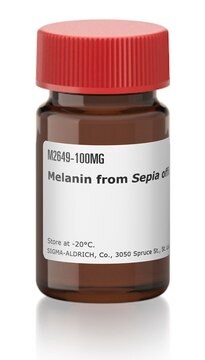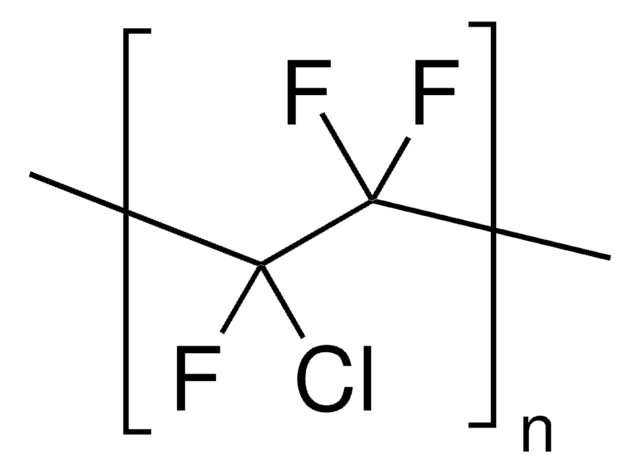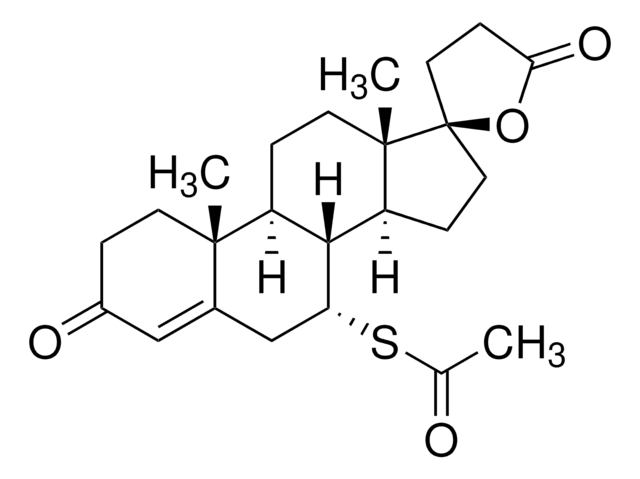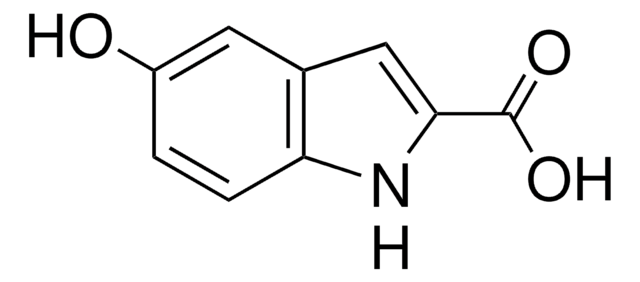M0418
Melanin
BioReagent, Synthetic, suitable for cell culture
Zaloguj sięWyświetlanie cen organizacyjnych i kontraktowych
About This Item
Polecane produkty
pochodzenie biologiczne
synthetic
linia produktu
BioReagent
Próba
≥97% (TLC)
Formularz
powder
metody
cell culture | mammalian: suitable
rozpuszczalność
1 N NH4OH: 20 mg/mL
temp. przechowywania
−20°C
InChI
1S/C18H10N2O4/c1-5-13-9-7(3-19-13)12-10-8(11(9)17(23)15(5)21)4-20-14(10)6(2)16(22)18(12)24/h3-4,19-20H,1-2H3
Klucz InChI
XUMBMVFBXHLACL-UHFFFAOYSA-N
Szukasz podobnych produktów? Odwiedź Przewodnik dotyczący porównywania produktów
Opis ogólny
Melanin is a distinctive class of pigment found in animals, plants, bacteria, and fungi. It is an amorphous polymer formed by the polymerization of phenolic and indolic compounds.
Zastosowanie
Melanin has been used:
- to incubate normal human keratinocytes for Masson-Fontana staining
- as a standard in the determination of melanin content in normal human epidermal melanocytes and immortalized human keratinocytes
- as an absorber to mimic human skin or melanocytic nevi and melanoma
Działania biochem./fizjol.
Melanin plays a role in camouflage and energy harvesting. It also helps in protection against ionizing UV radiations, protection against biotic factors such as host defense against pathogens, and abiotic factors like heat, cold and osmotic stress. Melanin acts as a potent cation chelator and is a component of several photoprotective creams as it facilitates free radical scavenging activity. Melanin may be useful as a photo protectant in cell culture.
Uwaga dotycząca przygotowania
Prepared by oxidation of tyrosine with hydrogen peroxide.
Ta strona może zawierać tekst przetłumaczony maszynowo.
Kod klasy składowania
11 - Combustible Solids
Klasa zagrożenia wodnego (WGK)
WGK 1
Temperatura zapłonu (°F)
Not applicable
Temperatura zapłonu (°C)
Not applicable
Środki ochrony indywidualnej
Eyeshields, Gloves, type N95 (US)
Wybierz jedną z najnowszych wersji:
Masz już ten produkt?
Dokumenty związane z niedawno zakupionymi produktami zostały zamieszczone w Bibliotece dokumentów.
Klienci oglądali również te produkty
Michael Waisberg et al.
PloS one, 7(1), e29493-e29493 (2012-01-14)
Malaria has had the largest impact of any infectious disease on shaping the human genome, exerting enormous selective pressure on genes that improve survival in severe malaria infections. Modern humans originated in Africa and lost skin melanization as they migrated
Naira V Margaryan et al.
International journal of molecular sciences, 17(3), 418-418 (2016-03-25)
Expression of Nodal, a Transforming Growth Factor-beta (TGF-β) related growth factor, is associated with aggressive melanoma. Nodal expression in adult dysplastic nevi may predict the development of aggressive melanoma in some patients. A subset of pediatric patients diagnosed with giant
Li Ni-Komatsu et al.
Molecular pharmacology, 74(6), 1576-1586 (2008-09-20)
A series of quinolines, including chloroquine and quinine, were identified as potent pigmentation inhibitors through screening a compound library in murine melanocytes. Structure-activity relationship analysis indicated that 4-substituted amino groups with a tertiary amine side chain, such as chloroquine, were
Nasz zespół naukowców ma doświadczenie we wszystkich obszarach badań, w tym w naukach przyrodniczych, materiałoznawstwie, syntezie chemicznej, chromatografii, analityce i wielu innych dziedzinach.
Skontaktuj się z zespołem ds. pomocy technicznej










